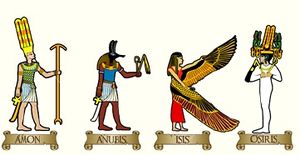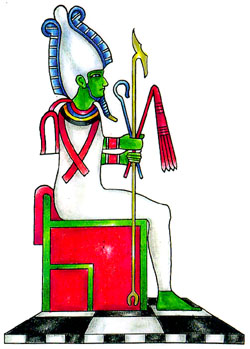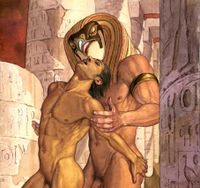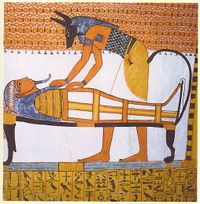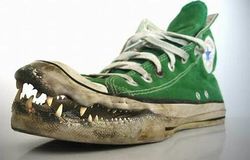Egyptian Gods
Egyptian mythology, like Christianity, is plagued with conflicting and competing creation stories and ethically dubious moral lessons making both creeds equally difficult to understand. However, Confucius tells us there are many paths to God and that one of them may be to conscript several thousand casual acquaintances to build a six-million-ton mausoleum in your honour before asking one of them to store your internal organs in jars, desiccate your corpse and wrap it with bandages. It would be a mistake, therefore, not to investigate the lessons Egyptian mythology can teach us.
We cannot hope to comprehend every one of the estimated two thousand Egyptian deities any more than we can fully understand the seemingly endless profusion of gods in the Hindu and Jewish religions. However, after death, a familiarity with the most important of these ancient deities may prove useful should we discover that the Iron Age myth of the Old Testament and the insane ramblings of deranged Judean carpenters turn out not to be the Gospel truth.
Isis and Osiris
The story of Isis and Osiris is central to Egyptian mythology. Isis was the daughter of the dour but grounded Earth god, Geb, and the bright but mentally fragile sky goddess, Nut. It was inevitable that she would eventually meet her husband, Osiris, as he was also her brother. There is no record of this incestuous marriage having been forced on the siblings though this was common in Ancient Egypt as it saved on wedding presents. Indeed, Isis and Osiris appear to have adored each other and may have settled down to raise a boatful of amusingly deformed demi-gods had Osiris not been in continual feud with Seth, god of the desert.
Seth was also Osiris's brother and their feud is generally accepted to be due to his jealousy at Osiris's marriage leaving him with only their fatter, uglier sister Nephtys to wed. Whereas Osiris was the King of Ancient Egyptian style, appearing in the finest mummy shroud and the white crown of the Upper Kingdom; Seth is shown with the face of an unidentifiable monster with a hideous shock of uncontrollable red hair – rather like Lucille Ball.
Eventually, Seth drowned Osiris in the Nile and Isis is shown tormented by grief, kissing his lifeless face and beating her fists on his chest in anguish. The ancient Egyptians interpreted his subsequent resuscitation to Isis's magical powers, whereas modern scholars have suggested that this represents ancient knowledge of CPR techniques.
Seth, however, determined to kill Osiris a second time in a way that even Isis would be unable to undo. Osiris was cut into multiple parts and hidden throughout Seth's desert empire. It took Isis many years to locate nearly all the body parts which she stitched back together. She then strapped the remains to a slab in the tallest tower of the highest Egyptian castle. Here the body awaited a lightning strike that would re-animate Osiris, complete but for the brain of a desert gerbil which Isis had been forced to substitute at the last minute. After weeks of waiting a summer storm struck the tower and the revived but damaged Osiris spent the rest of eternity jogging inside an exercise wheel, stuffing his cheeks with sunflower seeds and attempting to eat his offspring.
Horus
The unlikely union of Isis and Osiris produced another major deity – Horus. Like his mother, Horus was a sky-god and was born with the head of a hawk. This appears to have caused some difficulties for Isis as, at his first sight of his son, Osiris is recorded to have broken off from sharpening his teeth on a cuttlefish to exclaim: "He looks nothing like me! Are you sure you haven't been sneaking around with Nekhebet?"
Osiris calmed his fears by pointing out that Horus "has your eyes, darling," and the baby's life was spared to avenge of his father's murder by killing "Uncky Seth". Little is recorded about Horus's early years, though it is known that both Osiris and Isis suffered from the constant stress of hunting small prey animals to feed him and the difficulty of hauling them to the top of the cypress tree where Horus insisted his cot was kept. Horus is thought to have enjoyed his early years in education but, growing fast, was expelled from elementary school shortly after growing adult plumage. This incident appears to coincide with the discovery after morning assembly of the dismembered and partly consumed body of Bopi, rabbit-headed god of cuteness.
Years of vicious warfare followed, broken only by Horus's occasional need to hover over the Saharan dunes and swoop down on unsuspecting rodents in the papyrus reeds. Eventually, Horus confronted Seth in a cataclysmic final battle in which he lost his left eye. However, at the same time he managed to cut away Seth's testicles with his sharply curved talons.
From this point, the final history of Seth becomes a bit unclear. Some versions of Seth's story state that in a final act of vengeance, Horus exiled him for eternity. Other tales contend that this decision was left up to the ancient Egyptian gods who chose instead to force him to change his name to "Lucy Long-time" and dance in women's clothing for the entertainment of visitors at the otherwise unknown temple of "Ba'ah Nkok".
After the battle Seth restored Horus's missing eye but, in an act that had a long-lasting effect on the royal headdress of Egypt's Pharoahs, Horus gave the eye to his father (who was still collecting spare body parts "just in case"). Horus replaced the missing eye with a desert cobra to represent the sacred serpent and to impress the Goth goddess across the road – his mother having put her foot down about tattoos or piercings.
Anubis
Another major deity was Anubis, the jackal-headed god of embalming. It is thought that the cunning of this solitary and mysterious creature first inspired the ancient Nile people to associate them with one of their most important rites. That and the habit of jackals of hanging around in graveyards at night hoping to snaffle a quick bite of liver from an unguarded coptic jar.
In many versions of the myths, Anubis is portrayed as the son of Ra – the sun god, generally shown smoking sacred incense and preaching of the evils of neighbouring Babylon. In other versions he is the god of stargates, holding dominion over inter-dimensional portals with an army of Kulls and charged with the duty of chasing away Bast, goddess of cats. The most common story, however, sees Horus's persistent begging for a puppy being rewarded with a visit to the pound where he selects Anubis despite Osiris's weary explanation that "the runty ones never live." When Horus loses interest in trying to house train in him, and Anubis has chewed the slippers of the great sky gods one too many times, he is tied to a lamp-post in the underworld and abandoned again.
It was in the underworld that Anubis became the "Keeper of Divine Justice", entrusted by the gods with the role of sorting worthy souls from the unworthy. Those souls found to have lived a sin-free life were granted an eternal home in Aaru (paradise), while those found wanting were thrown to Aamit (the devourer of souls).
Initially, Anubis made his judgment by weighing the hearts of the deceased against Ma'at (god of truth), generally depicted as an ostrich feather. After a number of centuries it was clear that Aaru was a resoundingly empty place whereas Aamit was suffering from dangerously high blood pressure due to morbid obesity. At this point Anubis lowered Aaru's entrance requirements – allowing in whomever could scratch their own back with their hind legs, lick their own testes or successfully catch their own tails.
Thoth
Thoth was one of the most important deities of the Egyptian pantheon having gifted hieroglyphs to the Nile people. Nevertheless, he remains a mystery – sometimes depicted with the head of an ibis and at other times with the head of a baboon.
Thoth was seen as a great mediator between men and each god, and among the gods themselves. It is he who intervened in the climactic battles between Horus and Seth, healing the injured so that neither gained the upper hand. Consequently, he is frequently shown waving a towel in front of one of their faces, applying Vaseline to cut cheeks, and washing their gum-shields.
His representation as an ibis (a stork-like bird) is symbolic of intelligence and learning since the ibis dips its long curved beak in the mud much as a scribe dips his pen in ink. This beak therefore meant that Thoth was revered as a possessor of great wisdom and admired for his ability to eat spaghetti gracefully. As the nocturnal, intelligent baboon, Thoth is a representation of the Moon god, hiding his shamefully swollen buttocks from gaze by emerging only at night.
The Book of Thoth
More than any other except the Book of the Dead, one spell-book was revered across both the Upper and Lower Kingdoms. Celebrated in the popular song "Tell Me, Who Wrote the Book of Thoth", this seminal tome contained only two spells. Reading the first aloud enabled one able to understand the words of every beast. However, the Book of the Dead warned Egyptians against doing so, advising that "Animals rarely speak of anything save the possibility of being given a tidbit or having their tummy tickled." Reading the second spell enabled one to bring the dead to life. Again, sacred texts warned against invoking this spell saying, "The dead rarely speak of anything save the rudeness of current generations and the possibilities of being given some brains to snack on."
Prince Setna knew the book was hidden in a royal tomb in the City of the Dead. With his brother Anhurerau, he broke into a tomb and found the mummies of Neferkaptah, and his wife and young son. The wife warned them that her husband had stolen the Book and had read the spells only for Thoth to drown her and her son in the Nile in anger. Neferkeptah had then killed himself in despair that his dyslexia prevented his signing his name on their life insurance claims.
Then the mummy of Neferkaptah sat up and demanded to play four games of draughts. Setna lost the first and sank into the ground up to his ankles. After the next game he sank up to his hips. As he was losing the third game, he sent his brother to fetch his magic wand before sinking up to his chin.
He played the fourth game as slowly as he could but the mummy was too good to beat, having had little to do but practice draughts in the several centuries since his death. Just as Setna had nearly lost for the final time, his brother returned and struck the mummy's head with the wand. The spell was broken, and Setna grabbed the Book of Thoth.
As he tried to read the Book, Setna saw a beautiful woman and fell in love with her. He tried to persuade her to marry him but she, as is still common today in divorce cases, demanded that he kill his existing wife and children. Setna stabbed his wife and threw his children into the Nile in a sacks weighed down with bricks. She vanished, and he was appalled at what he had done, realising that he needed the bricks if he was ever to complete his own pyramid.
Lesser-known gods
There are deities of great importance to the Ancient Egyptian who have made little or no impression on the modern mind. But there are, after all, a multitude of gods to chose from and who would have heard of Christ had it not been for Mel Gibson's 2004 film?
One such god was Bast, the god of cats. Bast is represented with the head of a lion and was one of the most important gods of war in the Old Kingdom. She is shown emerging from the forest to destroy the chariots of Egypt’s enemies and, between battles, resting on a rug in front of a fire and playing with a giant ball of wool at the temple of Bubastis. Worshippers of Bast regularly sacrificed canaries to her greater glory and, at the third full moon of the year, attempted to cough up hair balls in her honour. The temple at Abu Simnel was dedicated to Bast and she is shown alongside Jair-Re (god of mice) endlessly battling each other with frying pans, garden hoses and bowling balls.
Hathor was an Ancient Egyptian goddess who personified love, beauty, music and joy. She was also the personification of motherhood, an institution so revered by Egyptians that they gave her the head of a cow. Despite being the daughter of the sun god (Ra), she gave birth to him each morning. In an intricately incestuous relationship little understood outside Louisiana and Norfolk, she is also her father/child's wife and conceives with him during the day so that he may be reborn once more next morning. Between times she grazed the banks of the Nile before devouring him in the evening and digesting him in one of her five stomachs.
Initially Tawaret was an Egyptian goddess of fertility and, as such, was feared as particularly unpredictable and aggressive for three or four days each month. Eventually she became revered as the goddess of childbirth and was represented with the head of a hippo and a grossly distended belly. Her breasts are generally shown to be pendulous and, in later centuries, her back is that of a crocodile. Tawaret protects mother and child alike by emotionally blackmailing the (male) gods of chaos into repainting their temple and buying unnecessary numbers of blankets, nappies and baby clothes. Like pregnant women across the planet, she marked her place in the world by rolling in mud and spraying her faeces across the river with a short but powerful tail.
Sobek represented the power and fertility of the Nile itself and was generally shown as a crocodile. He repaired the evil done to the land by the sins of mankind as well as providing hard-wearing footwear and attractive handbags.
While these gods are lesser known, the Egyptian gods Slifer, Obelisk, and Ra have gained increased popularity due to their appearance in the massively popular Yu-Gi-Oh card came, with their coincidentally being the gods of decks, cards, and poker respectively.
